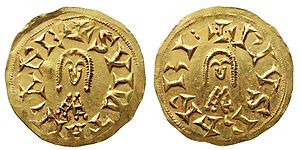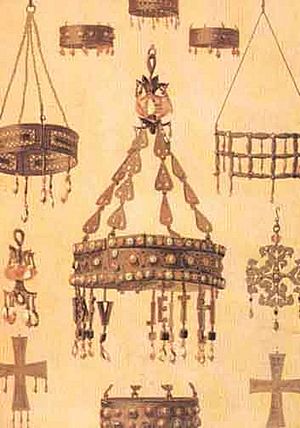Suintila facts for kids
Suintila was a Visigothic King who ruled parts of what is now Spain, Portugal, and southern France from 621 to 631. He was born around 588 and died between 633 and 635. Suintila was the son of King Reccared I. During his time as king, the Visigothic Kingdom experienced a rare period of peace and unity. This allowed him to gather a strong army and take back lands that were controlled by the Eastern Roman Empire by 624.
Contents
Who Was King Suintila?
Before becoming king, Suintila was a general. He fought against the Byzantines (people from the Eastern Roman Empire) who had invaded the Iberian Peninsula in 620. This was under the orders of King Sisebut.
In 621, after King Sisebut and Reccared II died, Suintila was chosen to be the new king. Once he became king, he brought a time of peace to Hispania (the old name for the Iberian Peninsula). For many years, there were no foreign armies on its land.
Uniting the Kingdom
Suintila successfully drove the Byzantines out of their strongholds in the eastern part of the country. A writer named Isidore of Seville said that Suintila was the first king to rule all of Spain. King Sisebut had started this work by taking back cities like Cartagena and Malaga. Suintila finished it in 624 when he captured the last Byzantine areas in Algarve.
Suintila's victories greatly weakened the Byzantine Empire's power in the region. Their army became much smaller. Like an earlier king named Liuvigild, Suintila also tried to bring the Basques (a group of people in the northern part of Spain) under his control. This led to the creation of a new town called Ologicus, which some believe is where the city of Olite in Navarre is today.
A King's Reputation
Isidore of Seville described Suintila as a good leader. He said Suintila had strong faith, was wise, hardworking, and fair in his decisions. He also mentioned that Suintila cared deeply about his kingdom, was generous to everyone, and kind to the poor. Isidore believed Suintila was not just a ruler but also "the father of the poor."
However, not everyone agreed with this view. Another historical text, the Chronicle of Fredegar, says that Suintila became disliked by many. Some nobles, who had helped him rise to power, turned against him. In 631, a noble named Sisenand started a rebellion. He got help from the Frankish king, Dagobert I.
Frankish generals arrived in Saragossa and declared Sisenand the new king of the Goths. In 633, a big meeting of church leaders and nobles, called the Fourth Council of Toledo, officially supported Sisenand. Suintila was accused of various wrongdoings, forced to give up his power, and sent away from the kingdom with his family. He also lost all his belongings.
Historical Discoveries
In 1858, a farmer found a very important treasure while plowing his field. This discovery is known as the Treasure of Guarrazar and Torredonjimero. It included eleven special crowns that were used for religious purposes. Three of these crowns had names on them: Suintila, Reccaswinth, and Sónnica. These crowns are important historical artifacts that tell us more about the Visigothic period.
See also
 In Spanish: Suintila para niños
In Spanish: Suintila para niños



